|
[Front Page] [Features] [Departments] [Society Home] [Subscribe]

Plants of the Newnes Plateau
Ian Cox
The area known as the Newnes Plateau is the habitat of many uncommon and unusual plants. This is a report on a Field Trip to the area led by Philip Moore in November 1995.
The Newnes Plateau, located north of Lithgow and Bell in the upper Blue Mountains, forms part of the Great Dividing Range. The southern portion of the Plateau is largely State Forest. To the north it includes parts of the new Gardens of Stone National Park and the wild Wollemi National Park.
The underlying rock is Narrabeen sandstone, which has been eroded by the Wolgan River in the west and other streams, leaving rugged ridges with rocky outcrops and deep gullies. The soil is generally poor and the weather harsh, with cold winters and hot summers. These conditions, where only the toughest plants can survive, have encouraged a flora with greater species diversity than in areas with more favourable circumstances.

| |
Access to Newnes Plateau is via forest roads leading north from the Zig Zag tourist railway station at Clarence. Refer 1:100000 topographical map "Wallerawang" or 1:25000 topographical maps "Lithgow" and "Cullen Bullen".
|
We left our meeting place near the Zig Zag Railway Station first thing on Saturday morning 27th November 1995, and drove along the old Bells Line of Road. We didn't have far to go to reach our first botanising stop - only a few hundred metres. It was a flat, open forested area with a good variety of species, which had regenerated well after a fire perhaps two or three years ago. Here we found the first of the multitude of Persoonia species we were to see over the weekend.
Persoonia recedens is a low spreading shrub which until recently was known as a subspecies of P.nutans. Its habitat is restricted to the upper Blue Mountains, as is that of P.myrtilloides ssp.myrtilloides, also nearby. Bordering the road were vibrant light-green carpets of P.chamaepitys - the flowers of which we inspected with a hand lens to view the distinctive hairy ovary. Phil identified another Persoonia here as closely resembling P.oxycoccoides, but this was probably an intergrade - the Flora of New South Wales lists the only habitat of that species as the Southern Highlands.
Boronia microphylla, flowering abundantly here, gave a softly colourful backdrop to the understorey. Its range of colours was from red to pale pink and even pure white. Phil explained that the white form of flower may be produced if only one enzyme is lacking during the chain of chemical reactions required for the plant to grow. This led to a discussion on the reasons for inaccurate colours of flowers in photography. Sometimes a photo of a blue Dampiera comes out almost pink. This is because the eye and the film collect different wavelengths of light.
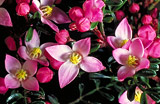 |
Boronia microphylla is one of several boronias that occur on the plateau.
Select the thumbnail image or highlighted name for a higher resolution image (29k).
|
The heath form of Hakea dactyloides, with bronze-coloured new growth, was common here. Phil mentioned that this form (with lignotuber) was so different to the forest form that it should probably be given separate species status.
Proceeding down the road just past the sandmining operation, we admired an attractive stand of the inland form of Astrotricha longifolia in full bloom. These plants could take their place in any garden! Phil also pointed out an unusual form of Lomandra longifolia, with short leaves and flower stems and quite a sparse habit.
The next stop was Murray's Swamp. We came here to see several rare plants - the first, Boronia deanei, was flowering in a number of locations in and around the swamp. B.deanei is a nationally significant threatened species with a vulnerable classification. The second was Grevillea x gaudichaudii - the natural hybrid which was once thought to be a species. Here it was growing midway between its parents - G.acanthifolia in the swamp, and the ground- covering G.laurifolia on the drier bank. It was easy to see why both G.acanthifolia and G. x gaudichaudii would welcome a moist spot in the garden. A third rare plant we observed was Isopogon prostratus, its matted foliage hugging the ground amongst the pines.
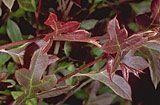 |
Grevillea x gaudichaudii (top) is a naturally occurring hybrid between Grevillea acanthifolia (middle) and Grevillea laurifolia (bottom). G x gaudichaudii shows intermediate characteristics between the two parents, particularly in the foliage. The hybrid is found only in the upper Blue Mountains and can be quite variable in habit.
Select the thumbnail image or highlighted name for a higher resolution image (25k, 22k and 33k).
| 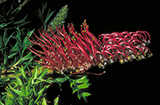 |  |
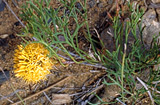 |
Isopogon prostratus can be a difficult plant to find when not flowering as it scrambles among taller grasses.
Select the thumbnail image or highlighted name for a higher resolution image (50k).
|
Growing in the swamp with its blue-violet racemes was Derwentia blakelyi. This plant, until recently classified as a Parahebe, also has a restricted distribution. A white form of Stylidium graminifolium is also found here.
Reflecting the altitude of almost 1,000 metres, Celmisia longifolia (Snow Daisy), and Eucalyptus pauciflora (Snow Gum) grow around Murray's Swamp, both being close to the northern extremity of their range. The Celmisia genus is currently under review, and this particular Celmisia, although at present included in the longifolia species complex, could well be reclassified as a separate species during the review.
The vegetation in Murray's Swamp is rather low - nothing is much over a metre high. It was a sea of pastel colours - the delicate green hues of the grasses, sedges and other plants harmonised with the pink of the boronias and grevilleas and the white of Epacris and Conospermum - a vista extending over several hectares flanked by the pines. Unfortunately this unique plant community is not protected, being in State Forest.
Continuing along the Glow-worm Tunnel road, we stopped to explore a dry rocky area with large sandstone pagoda formations. Here in exposed pockets of the pagodas was Leucochrysum graminifolium (formerly named Helipterum albicans variety graminifolium). This delightful herb with pale yellow flower heads and grasslike leaves is endemic to Newnes Plateau. - it is never located away from the rocks. Here too was a distinctive form of Calytrix tetragona, widespread on the Newnes Plateau, with yellow buds and creamy-white flowers.
Nearby, complimenting the stark and striking beauty of the pagodas, were many Callitris trees. In the Sydney region there are three species of Callitris - C.endlicheri, C.muelleri and C.rhomboidea, and all three are found in the more exposed and rocky parts of the Plateau.
The Newnes Plateau is the home of a number of uncommon banksias. Banksia penicillata is endemic in a few restricted populations and does well in cultivation in Sydney. Hybrids with B.marginata occur at a couple of locations near here. Also found in the area is a hybrid between B.ericifolia and B.cunninghamii. Of the very few Banksia hybrids in the wild throughout Australia, two exist on the Plateau! B.paludosa, which is allied to B.penicillata, is also on the Plateau near the northern limit of its distribution.
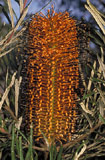 |
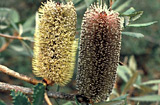 |
|
Banksia cunninghamii (left) is closely related to B.spinulosa. Banksia penicillata (right) is known only from the Plateau and, at the bud stage, the flowers may be pink through to deep brown.
Select the thumbnail image or plant names for higher resolution images (44k and 34k).
|
Just before the first road tunnel we stopped and scrambled down a rocky bank. In a creek bed we found a sparse Prostanthera around 70 centimetres tall. Phil identified it as having affinity with Prostanthera rhombea, although it should probably be a separate species.
Proceeding down the track, we came to a vertical rockface dripping with water, from which hung branches of the white-flowered Epacris muelleri, found only in the upper Blue Mountains. We were also attracted to the pink goodenia-like flowers of Coopernookia barbata, which is uncommon in the Sydney region.
Alongside the track Phil showed us a Pultenaea which during a previous visit he was unable to key out to a described species. What was it? Harry volunteered to seek an answer from the herbarium in Sydney. The answer came back later from Peter Weston - an unnamed species related to Pultenaea glabra!
At the entrance to the glow-worm tunnel was a sign reading:
Give the worms a go -
keep the lights and noise low
|
We obediently complied as we entered the dark and damp of the old railway tunnel. Once our eyes adjusted, the worms rewarded us with a glittering display on the ceiling and walls.
We emerged from the far end of the tunnel into a different world. Here it was cool and green - we were in the midst of a forest of treeferns. Large and stately specimens of Dicksonia antarctica and Cyathea australis towered over Todea barbara and Blechnum nudum. The ferns continued along the track for several hundred metres as it followed the creek.
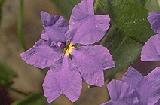 |
Dampiera stricta is a widespread species in eastern Australia. It forms an eye-catching carpet of deep blue flowers.
Select the thumbnail image or highlighted name for a higher resolution image (23k).
|
We camped overnight in the bush a short distance along Blackfellows Hand Trail, surrounded by a "garden" of Boronia microphylla and Dampiera stricta. On Sunday morning we continued west along Sunnyside Ridge Trail and turned north onto No 7 Fire Trail towards Wolgan Pinnacle. The trail ended on a finger of rock which juts out high above the Wolgan Valley. The view was magnificent. To the east the pagoda rock formations extended to the horizon on a series of ridges. "The Gardens of Stone" is certainly an apt name for this National Park.
We had a quick lunch, eager to explore this isolated place. Here again was the yellow/white Calytrix. Around the base of the pagodas was a low mint bush in flower - an unnamed variety of Prostanthera saxicola. The little Leucochrysum graminifolium was here too, brightening up the rocky pockets. Zieria aspalathoides and Z.cytisoides were not far away.
We scrambled around the pagodas towards the northern end of the ridge. After perhaps two or three hundred metres we came to a shallow gully containing a small forest of acacias - tall and slender - about 15 metres tall - with all the branches in the top three or four metres. The brown bark was flaky, of the “mini richi” type, and the phyllodes pale green and falcate. This was a new species, Acacia mathewii, whose description did not make the Flora of NSW. In the next little gully was Boronia rupii, similar in appearance to B.ledifolia, but having leaves with from three to seven leaflets.
The Newnes Plateau is shrouded in an aurora of mystery for native plant lovers. It is a place where you expect the unexpected. As usual we left convinced that there must be more unknown species awaiting discovery here. Who could disagree? After all, the "Wollemi Pine" is only tens of kilometres away!
From "Native Plants for New South Wales" newsletter of the Australian Plants Society (NSW), April 1996.

[Front Page] [Features] [Departments] [Society Home] [Subscribe]
Australian Plants online - June 2000
Association of Societies for Growing Australian Plants
|